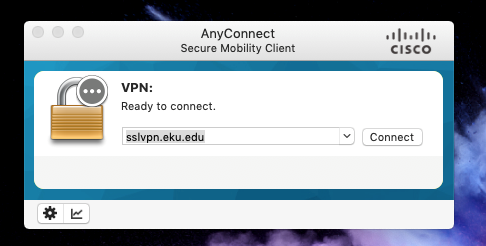
An Internet Protocol Security Virtual Private Network (IPSEC VPN) allows you to securely obtain remote resources by establishing an encrypted tunnel across the internet. The MAC built-in client, is a built in Client available on all MACs that allows you to connect to the VPN using IPSEC. This version supports TLS/DTLS (SSL) and IPsec IKEv2 VPN functions to the Cisco ASA. Guidelines and Limitations: - There is limited VPN performance on low-end. A VPN is a secured private network connection built on top of publicly accessible infrastructure. The Campus VPN service provides an alternative to using the proxy server for remote access to the UCLA Library and other campus resources. Campus VPN access is restricted to registered students and university employees with an active staff/faculty appointment. You will be required to enroll in.
Cisco AnyConnect is the recommended VPN client for Mac. The built-in VPN client for Mac is another option but is more likely to suffer from disconnects.
Overview
Stanford's VPN allows you to connect to Stanford's network as if you were on campus, making access to restricted services possible. Acura radio serial number. To connect to the VPN from your Mac you need to install the Cisco AnyConnect VPN client.
Two types of VPN are available:
- Default Stanford (split-tunnel). When using Stanford's VPN from home, we generally recommend using the Default Stanford split-tunnel VPN. This routes and encrypts all traffic going to Stanford sites and systems through the Stanford network as if you were on campus. All non-Stanford traffic proceeds to its destination directly.
- Full Traffic (non-split-tunnel). This encrypts all internet traffic from your computer but may inadvertently block you from using resources on your local network, such as a networked printer at home. If you are traveling or using wi-fi in an untrusted location like a coffee shop or hotel, you may wish to encrypt all of your internet traffic through the Full Traffic non-split-tunnel VPN to provide an additional layer of security.


You can select the type of VPN you want to use each time you connect.
Install the VPN client
- Download the Cisco AnyConnect installer for Mac.
- Double-click the InstallAnyConnect.pkg file to start the Cisco AnyConnect Installer wizard.
- When the Welcome window displays, click Continue.
- Select your hard drive as the destination where you want to install Cisco AnyConnect and then click Continue.
- Click Install to perform a standard installation of the software.
- At the prompt, enter your administrator account password for the Mac and click Install Software.
- When the software has finished installing, click Close.
Connect to the Stanford VPN
- To launch the VPN client, open your Applications folder and navigate to Cisco > Cisco AnyConnect Secure Mobility Client.app.
- When prompted for a VPN, enter su-vpn.stanford.edu and then click Connect.
- Enter the following information and then click OK:
- Group: select Default Stanford split- tunnel (non-Stanford traffic flows normally on an unencrypted internet connection) or Full Traffic non-split-tunnel (all internet traffic flows through the VPN connection)
- Username: your SUNet ID
- Password: your SUNet ID password
- Next, the prompt for two-step authentication displays.
- Enter a passcode or enter the number that corresponds to another option(in this example, enter 1 to authenticate using Duo Push on an iPad). You may have to scroll down the list to see all of your options. Then click Continue.
- If your only registered authentication method is printed list, hardware token, or Google Authenticator, the menu does not display. Enter a passcode in the Answer field and click Continue.
- Click Accept to connect to the Stanford Public VPN service.
- Once the VPN connection is established, the Cisco AnyConnect icon with a small lock appears in the dock.

Disconnect from the Stanford VPN
- Click the Cisco AnyConnect icon with a small lock.
- At the prompt, click Disconnect.
Current Status
Update for Mac VPN Client
Affected Services
- VPN
Event Updates
Upcoming Change:
On 1/9/2021, University Information Technology Services and Support will be releasing an upgrade for the Cisco AnyConnect VPN client.
Cisco Ssl Vpn Relay For Mac
Issue:
The latest version of the Mac operating system (Big Sur) is not compatible with the current version of the Cisco AnyConnect VPN client supported by UIT. Even though Big Sur is not yet supported by IT Support Center, users have already upgraded to it or have purchased a new Mac that has Big Sur on it and those folks are currently having issues using VPN. In order to provide service for these new and upgraded Macs, UIT is upgrading the VPN client for Mac users.

Here’s what to expect:
Cisco Ssl Vpn Relay Extension For Mac
When you launch your Cisco AnyConnect VPN client on your Mac after 1/9/2021, you will receive a notification that your Cisco AnyConnect Client is automatically being updated to the latest version. Allow the client to automatically update your software to the latest version, and then use as normal. No further action from you should be required after the upgrade has been completed.
If you are running the client on another computer that is not a Mac, the client will not be updated.
If you run into any difficulties or issues with the upgrade you may need to re-install the client, more information can be found at the link below:
Sonicwall Ssl Vpn On Mac
If you run into further difficulties, please contact Mark Norgan with IT Support Center at manorgan@central.uh.edu
